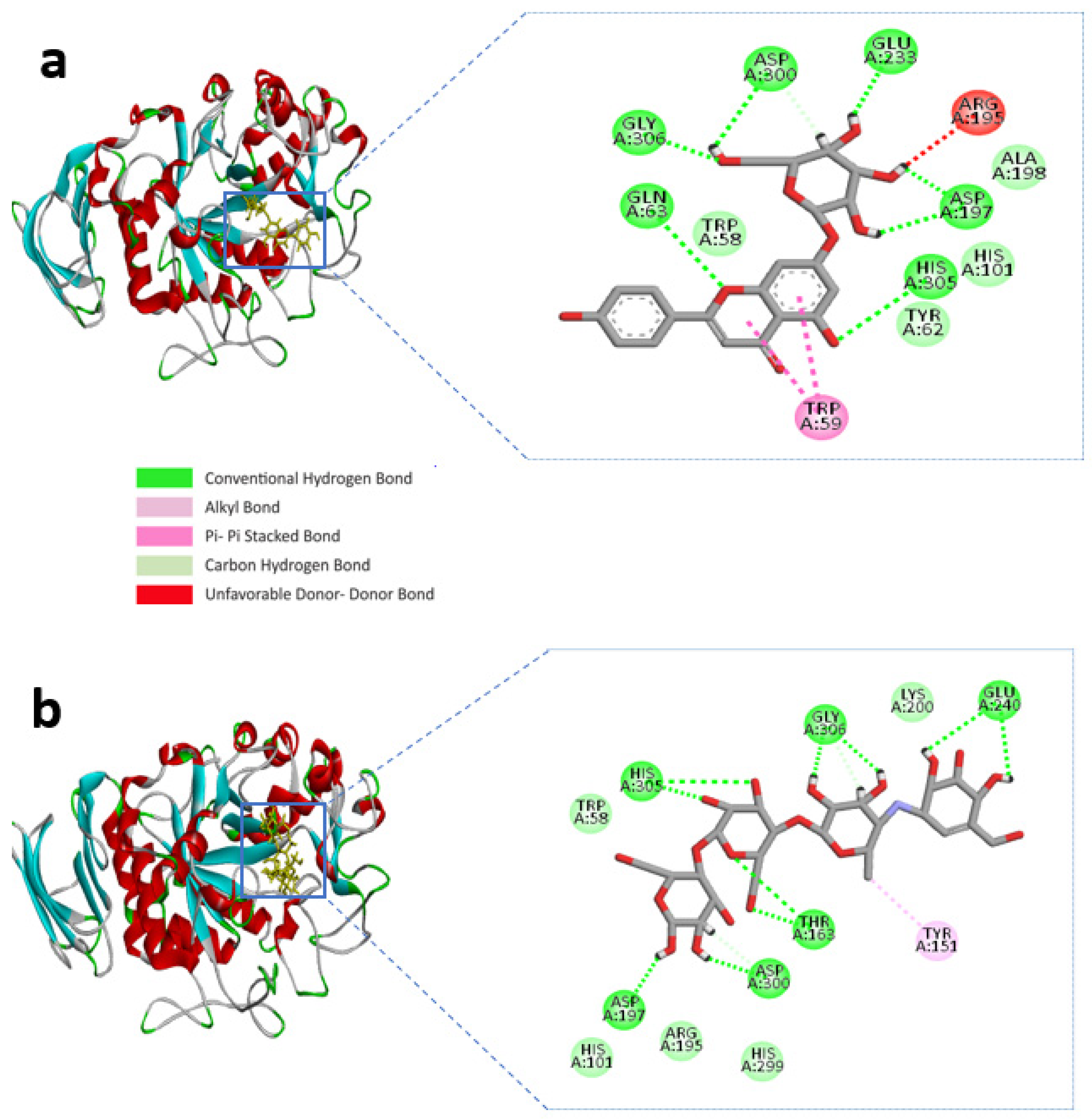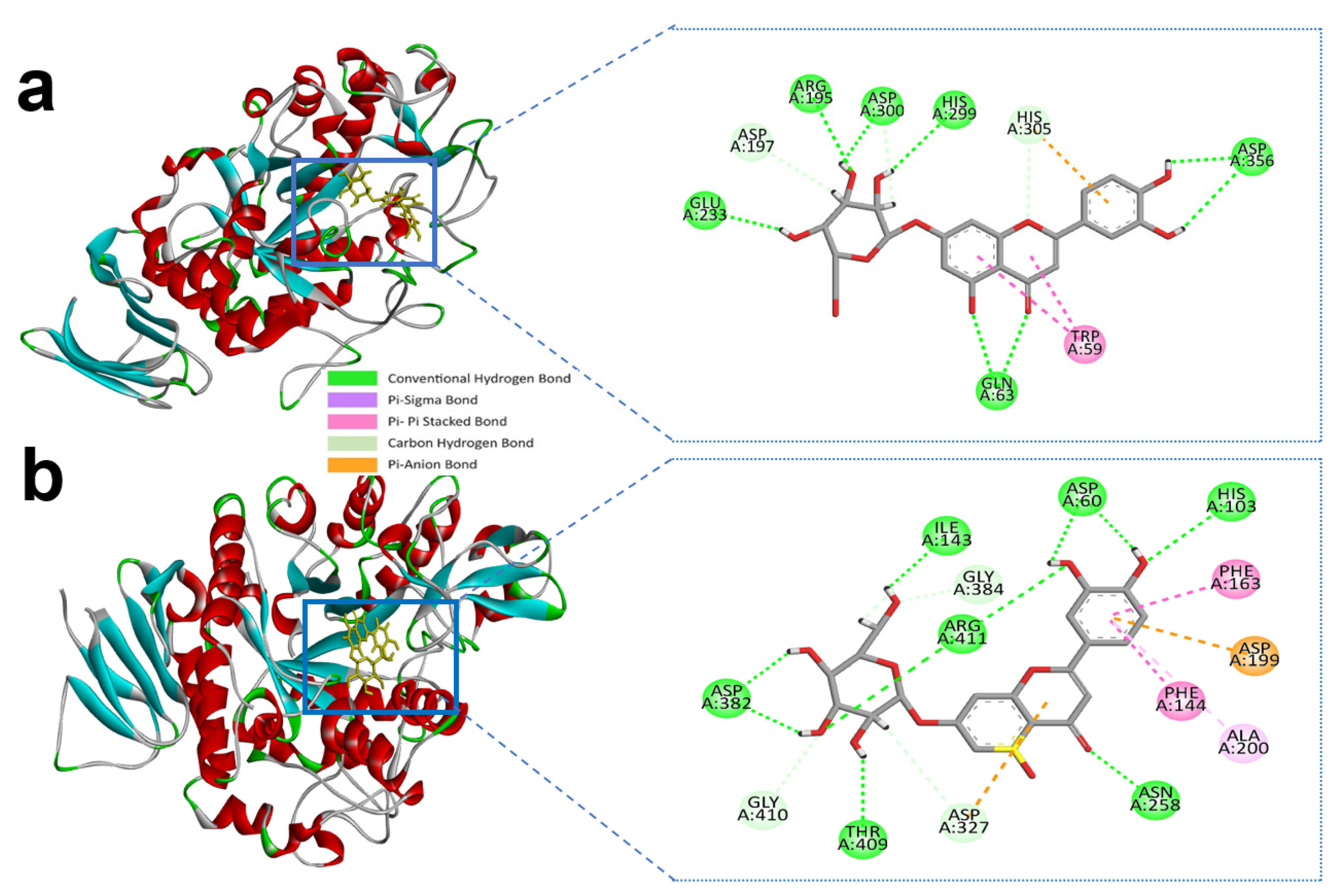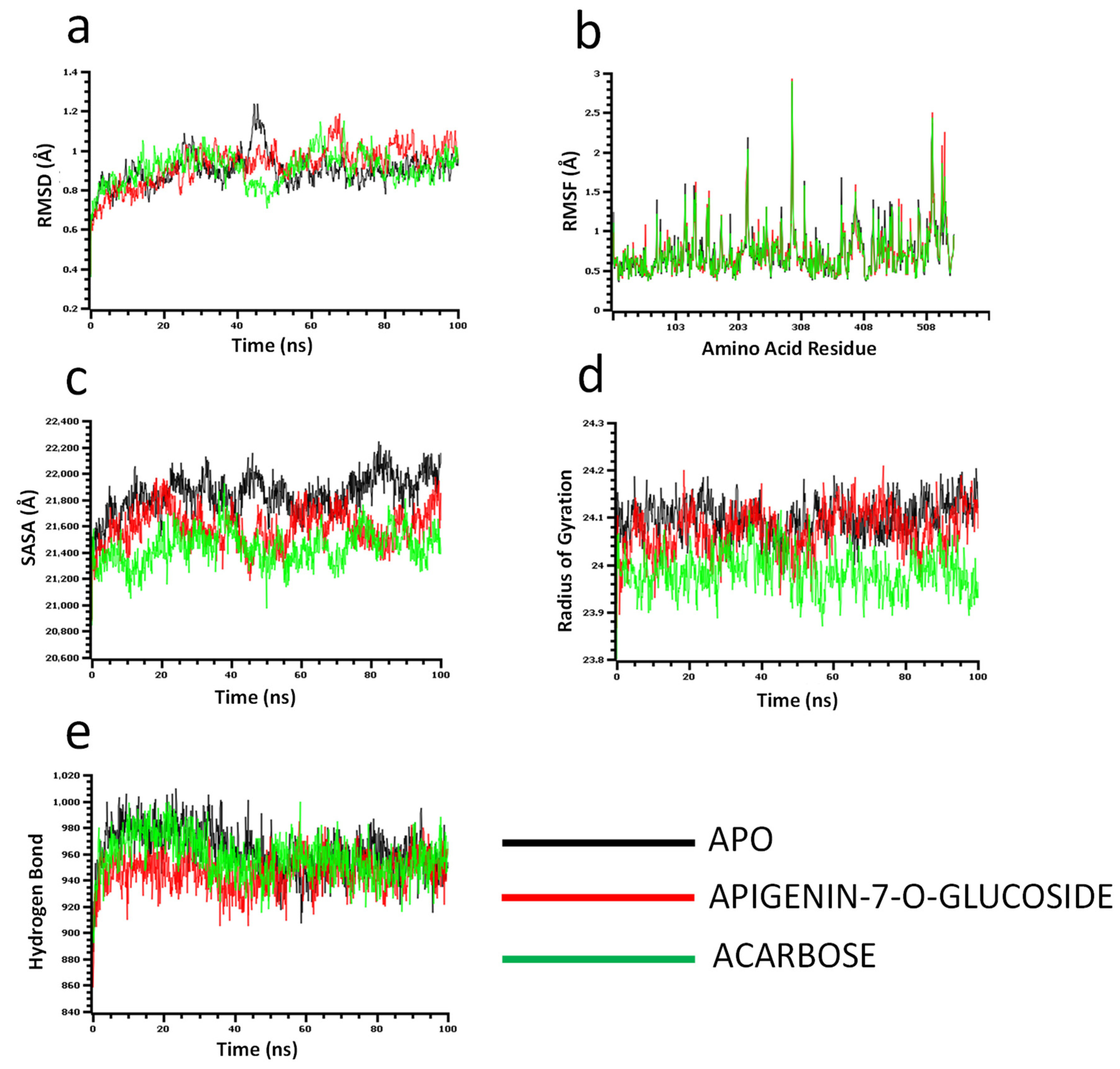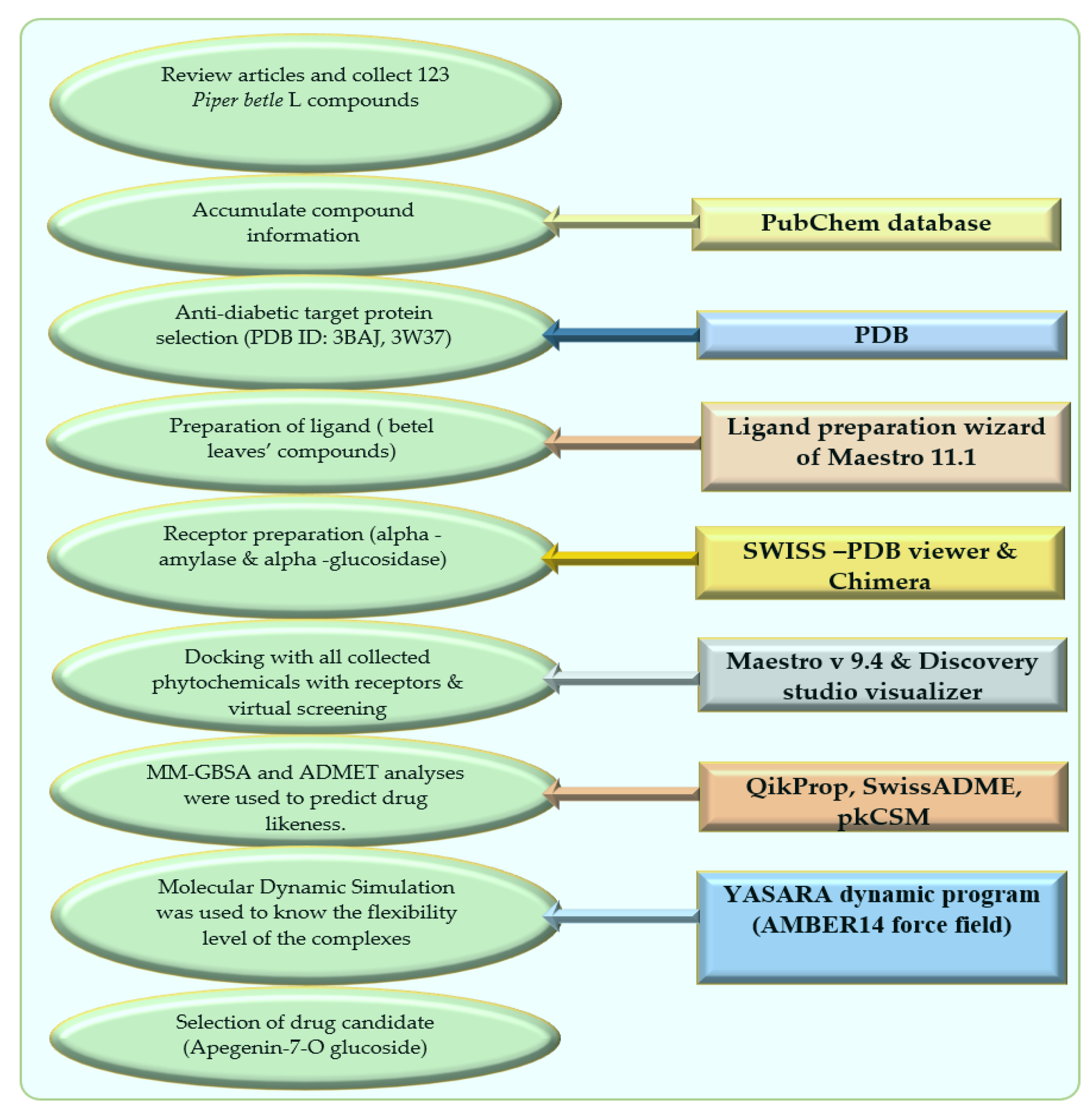Molecular Docking and Dynamics Simulation of Natural Compounds from Betel Leaves (Piper betle L.) for Investigating the Potential Inhibition of Alpha-Amylase and Alpha-Glucosidase of Type 2 Diabetes
Abstract
:1. Introduction
2. Results
2.1. Virtual Screening Based on Docking Scores of Compounds from Betel Leaves (Piper betle L.)
2.2. MM-GBSA Binding Affinity Estimation
2.3. Ligand Binding Analysis
2.4. ADMET Analysis Values
2.5. Molecular Dynamics Simulation
2.6. Pharmacokinetics and Drug Likeliness Properties
3. Discussion
4. Materials and Methods
4.1. Ligand Collection and Preparation
4.2. Receptor Preparation
4.3. Molecular Docking
4.4. Prime Molecular Mechanics—Generalized Born and Surface Area (MM-GBSA)
4.5. ADME/T Analysis and Pharmacokinetic and Drug-Likeliness Predictions
4.6. Molecular Dynamics Simulations
5. Conclusions
Supplementary Materials
Author Contributions
Funding
Data Availability Statement
Acknowledgments
Conflicts of Interest
References
- Jia, Y.; Ma, Y.; Cheng, G.; Zhang, Y.; Cai, S. Comparative Study of Dietary Flavonoids with Different Structures as α-Glucosidase Inhibitors and Insulin Sensitizers. J. Agric. Food Chem. 2019, 67, 10521–10533. [Google Scholar] [CrossRef] [PubMed]
- Marton, L.T.; Pescinini-e-Salzedas, L.M.; Camargo, M.E.C.; Barbalho, S.M.; Haber, J.F.D.S.; Sinatora, R.V.; Detregiachi, C.R.P.; Girio, R.J.S.; Buchaim, D.V.; Cincotto dos Santos Bueno, P. The Effects of Curcumin on Diabetes Mellitus: A Systematic Review. Front. Endocrinol. 2021, 12, 443. [Google Scholar] [CrossRef] [PubMed]
- Proença, C.; Freitas, M.; Ribeiro, D.; Oliveira, E.F.T.; Sousa, J.L.C.; Tomé, S.M.; Ramos, M.J.; Silva, A.M.S.; Fernandes, P.A.; Fernandes, E. α-Glucosidase inhibition by flavonoids: An in vitro and in silico structure–activity relationship study. J. Enzyme Inhib. Med. Chem. 2017, 32, 1216–1228. [Google Scholar] [CrossRef]
- Alqahtani, A.S.; Hidayathulla, S.; Rehman, M.T.; Elgamal, A.A.; Al-Massarani, S.; Razmovski-Naumovski, V.; Alqahtani, M.S.; El Dib, R.A.; Alajmi, M.F. Alpha-amylase and alpha-glucosidase enzyme inhibition and antioxidant potential of 3-oxolupenal and katononic acid isolated from Nuxia oppositifolia. Biomolecules 2020, 10, 61. [Google Scholar] [CrossRef]
- Fernández-Real, J.M.; Pickup, J.C. Innate immunity, insulin resistance and type 2 diabetes. Trends Endocrinol. Metab. 2008, 19, 10–16. [Google Scholar] [CrossRef]
- Nair, S.S.; Kavrekar, V.; Mishra, A. In vitro studies on alpha amylase and alpha glucosidase inhibitory activities of selected plant extracts. Eur. J. Exp. Biol. 2013, 3, 128–132. [Google Scholar]
- Hiyoshi, T.; Fujiwara, M.; Yao, Z. Postprandial hyperglycemia and postprandial hypertriglyceridemia in type 2 diabetes. J. Biomed. Res. 2019, 33, 1. [Google Scholar] [CrossRef]
- Peyrot des Gachons, C.; Breslin, P.A.S. Salivary Amylase: Digestion and Metabolic Syndrome. Curr. Diab. Rep. 2016, 16, 102. [Google Scholar] [CrossRef]
- Kazeem, M.I.; Adamson, J.O.; Ogunwande, I.A. Modes of inhibition of α-amylase and α-glucosidase by aqueous extract of morinda lucida benth leaf. Biomed Res. Int. 2013, 2013, 527570. [Google Scholar] [CrossRef]
- Stein, S.A.; Lamos, E.M.; Davis, S.N. A review of the efficacy and safety of oral antidiabetic drugs. Expert Opin. Drug Saf. 2013, 12, 153–175. [Google Scholar] [CrossRef]
- Van Quan, N.; Tran, H.D.; Xuan, T.D.; Ahmad, A.; Dat, T.D.; Khanh, T.D.; Teschke, R. Momilactones A and B are α-amylase and α-glucosidase inhibitors. Molecules 2019, 24, 482. [Google Scholar] [CrossRef] [PubMed]
- Tundis, R.; Loizzo, M.R.; Menichini, F. Natural Products as α-Amylase and α-Glucosidase Inhibitors and their Hypoglycaemic Potential in the Treatment of Diabetes: An Update. Mini-Rev. Med. Chem. 2010, 10, 315–331. [Google Scholar] [CrossRef] [PubMed]
- Munni, Y.A.; Ali, M.C.; Selsi, N.J.; Sultana, M.; Hossen, M.; Bipasha, T.H.; Rahman, M.; Uddin, M.N.; Hosen, S.M.Z.; Dash, R. Molecular simulation studies to reveal the binding mechanisms of shikonin derivatives inhibiting VEGFR-2 kinase. Comput. Biol. Chem. 2021, 90, 107414. [Google Scholar] [CrossRef] [PubMed]
- Ben Lamine, J.; Boujbiha, M.A.; Dahane, S.; Cherifa, A.B.; Khlifi, A.; Chahdoura, H.; Yakoubi, M.T.; Ferchichi, S.; El Ayeb, N.; Achour, L. α-Amylase and α-glucosidase inhibitor effects and pancreatic response to diabetes mellitus on Wistar rats of Ephedra alata areal part decoction with immunohistochemical analyses. Environ. Sci. Pollut. Res. 2019, 26, 9739–9754. [Google Scholar] [CrossRef] [PubMed]
- Brayer, G.D.; Luo, Y.; Withers, S.G. The structure of human pancreatic α-amylase at 1.8 Å resolution and comparisons with related enzymes. Protein Sci. 1995, 4, 1730–1742. [Google Scholar] [CrossRef]
- Dwivedi, V.; Tripathi, S. Review study on potential activity of Piper betle. J. Pharmacogn. Phytochem. 2014, 93, 9398. [Google Scholar]
- Shah, S.K.; Garg, G.; Jhade, D.; Patel, N. Piper betle: Phytochemical, pharmacological and nutritional value in health management. Int. J. Pharm. Sci. Rev. Res. 2016, 38, 181–189. [Google Scholar]
- Mohanto, S.; Datta, S.; Mandal, S. International Journal of Current Medical and Pharmaceutical Piper Betel Linn: A Brief Study. Int. J. Curr. Med. Pharm. Res. 2017, 3, 1290–1296. [Google Scholar]
- Arambewela, L.S.R.; Arawwawala, L.D.A.M.; Ratnasooriya, W.D. Antidiabetic activities of aqueous and ethanolic extracts of Piper betle leaves in rats. J. Ethnopharmacol. 2005, 102, 239–245. [Google Scholar] [CrossRef]
- Srividya, S.; Roshana Devi, V.; Subramanian, S. Hypoglycemic and hypolipidemic properties of hydroxychavicol, a major phenolic compound from the leaves of Piper betlelinn. studied in high fat diet fed- low dose STZ induced experimental type 2 diabetes in rats. Der Pharm. Lett. 2015, 7, 130–140. [Google Scholar]
- Kautzky-Willer, A.; Harreiter, J.; Winhofer-Stöckl, Y.; Bancher-Todesca, D.; Berger, A.; Repa, A.; Lechleitner, M.; Weitgasser, R. Gestational diabetes mellitus (Update 2019). Wien. Klin. Wochenschr. 2019, 131, 91–102. [Google Scholar] [CrossRef] [PubMed]
- Kavitha, S.; Perumal, P. Antidiabetic and antioxidant activities of ethanolic extract of Piper betle L. Leaves in catfish, clarias gariepinus. Asian J. Pharm. Clin. Res. 2018, 11, 194–198. [Google Scholar] [CrossRef]
- Fettach, S.; Thari, F.Z.; Hafidi, Z.; Tachallait, H.; Karrouchi, K.; El Achouri, M.; Cherrah, Y.; Sefrioui, H.; Bougrin, K.; Faouzi, M.E.A. Synthesis, α-glucosidase and α-amylase inhibitory activities, acute toxicity and molecular docking studies of thiazolidine-2,4-diones derivatives. J. Biomol. Struct. Dyn. 2021, 13, 1–12. [Google Scholar] [CrossRef] [PubMed]
- Barrett, M.L.; Udani, J.K. A proprietary alpha-amylase inhibitor from white bean (Phaseolus vulgaris): A review of clinical studies on weight loss and glycemic control. Nutr. J. 2011, 10, 24. [Google Scholar] [CrossRef]
- Visualizer, D.S. BIOVIA Workbook, Release 2020; BIOVIA Pipeline Pilot, Release 2020; Dassault Systèmes: San Diego, CA, USA, 2020. [Google Scholar]
- Murugesan, S.; Ravichandran, D.; Lakshmanan, D.K.; Ravichandran, G.; Arumugam, V.; Raju, K.; Geetha, K.; Thilagar, S. Evaluation of anti rheumatic activity of Piper betle L. (Betelvine) extract using in silico, in vitro and in vivo approaches. Bioorg. Chem. 2020, 103, 104227. [Google Scholar] [CrossRef]
- Amin, S.A.; Bhattacharya, P.; Basak, S.; Gayen, S.; Nandy, A.; Saha, A. Pharmacoinformatics study of Piperolactam A from Piper betle root as new lead for non steroidal anti fertility drug development. Comput. Biol. Chem. 2017, 67, 213–224. [Google Scholar] [CrossRef]
- Patra, B.; Deep, S.K.; Rosalin, R.; Pradhan, S.N. Flavored Food Additives on the Leaves of Piper betle L.: A Human Health Perspective. Appl. Biochem. Biotechnol. 2022, 2022, 1–23. [Google Scholar] [CrossRef]
- Villa-rodriguez, J.A.; Kerimi, A.; Abranko, L.; Tumova, S.; Ford, L.; Blackburn, R.S.; Rayner, C.; Williamson, G. Acute metabolic actions of the major polyphenols in chamomile: An in vitro mechanistic study on their potential to attenuate postprandial hyperglycaemia. Sci. Rep. 2018, 8, 5471. [Google Scholar] [CrossRef]
- Hanefeld, M.; Schaper, F. Acarbose: Oral antidiabetes drug with additional cardiovascular benefits. Expert Rev. Cardiovasc. Ther. 2008, 6, 153–163. [Google Scholar] [CrossRef]
- Malaguarnera, M.; Giugno, I.; Ruello, P.; Rizzo, M.; Motta, M.; Mazzoleni, G. Acarbose is an effective adjunct to dietary therapy in the treatment of hypertriglyceridaemias. Br. J. Clin. Pharmacol. 1999, 48, 605–609. [Google Scholar] [CrossRef]
- Derosa, G.; Maffioli, P. α-Glucosidase inhibitors and their use in clinical practice. Arch. Med. Sci. 2012, 8, 899–906. [Google Scholar] [CrossRef] [PubMed]
- Bhushan, M.; Rao, C.V.; Ojha, S.K.; Vijayakumar, M.; Verma, A. An Analytical Review of Plants for Anti Diabetic Activity with Their Phytoconstituent & Mechanism of Action. Int. J. Pharm. Sci. Res. 2010, 1, 29–46. [Google Scholar]
- Kidane, Y.; Bokrezion, T.; Mebrahtu, J.; Mehari, M.; Gebreab, Y.B.; Fessehaye, N.; Achila, O.O. In Vitro Inhibition of α-Amylase and α-Glucosidase by Extracts from Psiadia punctulata and Meriandra bengalensis. Evid.-Based Complement. Altern. Med. 2018, 2018, 2164345. [Google Scholar] [CrossRef] [PubMed]
- Bhatia, A.; Singh, B.; Arora, R.; Arora, S. In vitro evaluation of the α-glucosidase inhibitory potential of methanolic extracts of traditionally used antidiabetic plants. BMC Complement. Altern. Med. 2019, 19, 74. [Google Scholar] [CrossRef]
- Brayer, G.D.; Sidhu, G.; Maurus, R.; Rydberg, E.H.; Braun, C.; Wang, Y.; Nguyen, N.T.; Overall, C.M.; Withers, S.G. Subsite mapping of the human pancreatic α-amylase active site through structural, kinetic, and mutagenesis techniques. Biochemistry 2000, 39, 4778–4791. [Google Scholar] [CrossRef]
- Rydberg, E.H.; Li, C.; Maurus, R.; Overall, C.M.; Brayer, G.D.; Withers, S.G. Mechanistic analyses of catalysis in human pancreatic α-amylase: Detailed kinetic and structural studies of mutants of three conserved carboxylic acids. Biochemistry 2002, 41, 4492–4502. [Google Scholar] [CrossRef] [PubMed]
- Wang, E.; Fu, W.; Jiang, D.; Sun, H.; Wang, J.; Zhang, X.; Weng, G.; Liu, H.; Tao, P.; Hou, T. VAD-MM/GBSA: A Variable Atomic Dielectric MM/GBSA Model for Improved Accuracy in Protein-Ligand Binding Free Energy Calculations. J. Chem. Inf. Model. 2021, 61, 2844–2856. [Google Scholar] [CrossRef]
- Zhang, X.; Perez-sanchez, H.; Lightstone, F.C. A Comprehensive Docking and MM/GBSA Rescoring Study of Ligand Recognition upon Binding Antithrombin. Curr. Top. Med. Chem. 2017, 17, 1631–1639. [Google Scholar] [CrossRef]
- Glassman, P.M.; Muzykantov, V.R. Pharmacokinetic and pharmacodynamic properties of drug delivery systems. J. Pharmacol. Exp. Ther. 2019, 370, 570–580. [Google Scholar] [CrossRef]
- Dash, R.; Choi, H.J.; Moon, I.S. Mechanistic insights into the deleterious role of nasu-hakola disease associated TREM2 variants. Sci. Rep. 2020, 10, 3663. [Google Scholar] [CrossRef]
- Leeson, P.D.; Young, R.J. Molecular Property Design: Does Everyone Get It? ACS Med. Chem. Lett. 2015, 6, 722–725. [Google Scholar] [CrossRef] [PubMed]
- Yunta, M.J.R. It Is Important to Compute Intramolecular Hydrogen Bonding in Drug Design? Am. J. Model. Optim. 2017, 5, 24–57. [Google Scholar] [CrossRef]
- Peele, K.A.; Potla Durthi, C.; Srihansa, T.; Krupanidhi, S.; Ayyagari, V.S.; Babu, D.J.; Indira, M.; Reddy, A.R.; Venkateswarulu, T.C. Molecular docking and dynamic simulations for antiviral compounds against SARS-CoV-2: A computational study. Inform. Med. Unlocked 2020, 19, 100345. [Google Scholar] [CrossRef]
- George Priya Doss, C.; Nagasundaram, N.; Chakraborty, C.; Chen, L.; Zhu, H. Extrapolating the effect of deleterious nsSNPs in the binding adaptability of flavopiridol with CDK7 protein: A molecular dynamics approach. Hum. Genom. 2013, 7, 10. [Google Scholar] [CrossRef] [PubMed]
- Wang, J.; Urban, L. The impact of early ADME profiling on drug discovery and development strategy. Drug Discov. World 2004, 5, 73–86. [Google Scholar]
- Chen, F.; Liu, H.; Sun, H.; Pan, P.; Li, Y.; Li, D.; Hou, T. Assessing the performance of the MM/PBSA and MM/GBSA methods. 6. Capability to predict protein-protein binding free energies and re-rank binding poses generated by protein-protein docking. Phys. Chem. Chem. Phys. 2016, 18, 22129–22139. [Google Scholar] [CrossRef]
- Wu, F.; Zhou, Y.; Li, L.; Shen, X.; Chen, G.; Wang, X.; Liang, X.; Tan, M.; Huang, Z. Computational Approaches in Preclinical Studies on Drug Discovery and Development. Front. Chem. 2020, 8, 726. [Google Scholar] [CrossRef]
- Madhavi Sastry, G.; Adzhigirey, M.; Day, T.; Annabhimoju, R.; Sherman, W. Protein and ligand preparation: Parameters, protocols, and influence on virtual screening enrichments. J. Comput. Aided. Mol. Des. 2013, 27, 221–234. [Google Scholar] [CrossRef]
- Berman, H.M.; Westbrook, J.; Feng, Z.; Gilliland, G.; Bhat, T.N.; Weissig, H.; Shindyalov, I.N.; Bourne, P.E. The Protein Data Bank. Nucleic Acids Res. 2000, 28, 235–242. [Google Scholar] [CrossRef]
- Guex, N.; Peitsch, M.C. SWISS-MODEL and the Swiss-PdbViewer: An environment for comparative protein modeling. Electrophoresis 1997, 18, 2714–2723. [Google Scholar] [CrossRef]
- Pettersen, E.F.; Goddard, T.D.; Huang, C.C.; Couch, G.S.; Greenblatt, D.M.; Meng, E.C.; Ferrin, T.E. UCSF Chimera—A visualization system for exploratory research and analysis. J. Comput. Chem. 2004, 25, 1605–1612. [Google Scholar] [CrossRef] [PubMed]
- Harder, E.; Damm, W.; Maple, J.; Wu, C.; Reboul, M.; Xiang, J.Y.; Wang, L.; Lupyan, D.; Dahlgren, M.K.; Knight, J.L.; et al. OPLS3: A Force Field Providing Broad Coverage of Drug-like Small Molecules and Proteins. J. Chem. Theory Comput. 2016, 12, 281–296. [Google Scholar] [CrossRef] [PubMed]
- Friesner, R.A.; Murphy, R.B.; Repasky, M.P.; Frye, L.L.; Greenwood, J.R.; Halgren, T.A.; Sanschagrin, P.C.; Mainz, D.T. Extra precision glide: Docking and scoring incorporating a model of hydrophobic enclosure for protein-ligand complexes. J. Med. Chem. 2006, 49, 6177–6196. [Google Scholar] [CrossRef] [PubMed]
- Dallakyan, S.; Olson, A. Participation in global governance: Coordinating “the voices of those most affected by food insecurity”. Glob. Food Secur. Gov. 2015, 1263, 123–152. [Google Scholar] [CrossRef]
- Sirin, S.; Pearlman, D.A.; Sherman, W. Physics-based enzyme design: Predicting binding affinity and catalytic activity. Proteins Struct. Funct. Bioinform. 2014, 82, 3397–3409. [Google Scholar] [CrossRef]
- Dash, R.; Junaid, M.; Mitra, S.; Arifuzzaman, M.; Hosen, S.M.Z. Structure-based identification of potent VEGFR-2 inhibitors from in vivo metabolites of a herbal ingredient. J. Mol. Model. 2019, 25, 98. [Google Scholar] [CrossRef]
- Li, J.; Abel, R.; Zhu, K.; Cao, Y.; Zhao, S.; Friesner, R.A. The VSGB 2.0 model: A next generation energy model for high resolution protein structure modeling. Proteins Struct. Funct. Bioinform. 2011, 79, 2794–2812. [Google Scholar] [CrossRef]
- Margulis, E.; Dagan-Wiener, A.; Ives, R.S.; Jaffari, S.; Siems, K.; Niv, M.Y. Intense bitterness of molecules: Machine learning for expediting drug discovery. Comput. Struct. Biotechnol. J. 2021, 19, 568–576. [Google Scholar] [CrossRef]
- Daina, A.; Michielin, O.; Zoete, V. SwissADME: A free web tool to evaluate pharmacokinetics, drug-likeness and medicinal chemistry friendliness of small molecules. Sci. Rep. 2017, 7, 42717. [Google Scholar] [CrossRef]
- Pires, D.E.V.; Blundell, T.L.; Ascher, D.B. pkCSM: Predicting small-molecule pharmacokinetic and toxicity properties using graph-based signatures. J. Med. Chem. 2015, 58, 4066–4072. [Google Scholar] [CrossRef]
- Krieger, E.; Vriend, G. New ways to boost molecular dynamics simulations. J. Comput. Chem. 2015, 36, 996–1007. [Google Scholar] [CrossRef] [PubMed]
- Land, H.; Humble, M.S. Chapter 4 in Biocatalytic Investigations. Protein Eng. Methods Protoc. 2018, 1685, 43–67. [Google Scholar] [CrossRef] [PubMed]
- Stewart, J.J.P. MOPAC: A semiempirical molecular orbital program. J. Comput. Aided. Mol. Des. 1990, 4, 1–105. [Google Scholar] [CrossRef] [PubMed]
- Jakalian, A.; Jack, D.B.; Bayly, C.I. Fast, efficient generation of high-quality atomic charges. AM1-BCC model: II. Parameterization and validation. J. Comput. Chem. 2002, 23, 1623–1641. [Google Scholar] [CrossRef]
- Wang, J.; Wolf, R.M.; Caldwell, J.W.; Kollman, P.A.; Case, D.A. Development and testing of a general amber force field. J. Comput. Chem. 2004, 25, 1157–1174. [Google Scholar] [CrossRef] [PubMed]
- Jorgensen, W.L.; Chandrasekhar, J.; Madura, J.D.; Impey, R.W.; Klein, M.L. Comparison of simple potential functions for simulating liquid water. J. Chem. Phys. 1983, 79, 926–935. [Google Scholar] [CrossRef]
- Hess, B.; Bekker, H.; Berendsen, H.J.C.; Fraaije, J.G.E.M. LINCS: A Linear Constraint Solver for molecular simulations. J. Comput. Chem. 1997, 18, 1463–1472. [Google Scholar] [CrossRef]






| Compounds | Interaction | Residues in Contact | Distance in Å |
|---|---|---|---|
| Apigenin-7-O-glucoside | Conventional hydrogen bond | ASP-300 | 2.41 |
| GLU-233 | 1.87 | ||
| ASP-197 | 1.86, 1.59 | ||
| HIS-305 | 2.65 | ||
| GLY-306 | 2.89 | ||
| GLN-63 | 2.87 | ||
| Carbon hydrogen bond | ASP-300 | 2.44 | |
| Unfavourable donor-donor | ARG-195 | 2.42 | |
| Pi-Pi stacked | TRP-59 | ||
| Luteolin-7-O-glucoside | Conventional hydrogen bond | ASP-300 | 1.68 |
| GLU-233 | 1.97 | ||
| HIS-299 | 2.35 | ||
| ASP-356 | 2.26, 2.82 | ||
| ARG-195 | 2.16 | ||
| GLN-63 | 2.27, 2.73, 2.89 | ||
| Carbon hydrogen bond | ASP-197 | 2.37 | |
| ASP-300 | 2.23 | ||
| HIS-305 | 2.54 | ||
| Pi-cation | HIS-305 | 2.52 | |
| Pi-Pi stacked | TRP-95 | 4.92, 5.55 | |
| 4.03, 4.29 | |||
| Quercetin | Conventional hydrogen bond | ASP-300 | 2.22 |
| ASP-197 | 1.78 | ||
| HIS-305 | 2.19, 2.84 | ||
| THR-163 | 2.09 | ||
| Carbon hydrogen bond | HIS-101 | 2.4 | |
| Acarbose | Conventional hydrogen bond | GLU-240 | 2.20, 2.02 |
| GLY-306 | 1.99, 1.73 | ||
| HIS-305 | 2.93, 2.11 | ||
| ASP-197 | 1.81 | ||
| ASP-300 | 1.68 | ||
| THR-163 | 3.01, 2.19 | ||
| Carbon hydrogen bond | GLY-306 | 2.54 | |
| ASP-300 | 2.51 | ||
| Pi-Pi stacked | TYR-151 | 3.84 |
| Compounds | Interaction | Residues in Contact | Distance in Å |
|---|---|---|---|
| Apigenin-7-O-glucoside | Conventional hydrogen bond | ASP-60 | 1.7 |
| ASN-258 | 2.01 | ||
| ASP-327 | 2.27, 2.98 | ||
| ILE-143 | 1.75, 2.61 | ||
| ASP-382 | 1.77, 2.06 | ||
| Carbon | ARG-411 | 2.05 | |
| GLY-384 | 3.09 | ||
| GLY-410 | 2.67 | ||
| Pi-Anion | ASP-327 | 3.98, 4.56 | |
| Pi-Pi stacked | PHE-163 | 4.52 | |
| Pi-Pi T shaped | TYR-63 | 5.44 | |
| Luteolin-7-O-glucoside | Conventional hydrogen bond | HIS-103 | 2.96 |
| ASP-60 | 1.61, 1.80 | ||
| ILE-143 | 1.75, 2.58 | ||
| ASP-382 | 1.77, 2.07 | ||
| THR-409 | 2.45 | ||
| ASN-258 | 2.04 | ||
| ARG-411 | 1.79, 2.05 | ||
| Carbon hydrogen bond | ASP-327 | 2.93, 3.99 | |
| GLY-410 | 2.67 | ||
| GLY-384 | 3.09 | ||
| Pi-Anion | ASP-199 | 4.32 | |
| Pi-Alkyl | ALA-200 | 5.24 | |
| Pi-Pi T shaped | PHE-144 | 5.8 | |
| Pi-Pi stacked | PHE-163 | 4.26 | |
| Quercetin | Conventional hydrogen bond | HIS-203 | 2.07 |
| ASN-258 | 2.08, 2.89, 2.90 | ||
| ASP-382 | 2.02, 2.07 | ||
| Pi-cation | ARG-411 | 4.97 | |
| Pi-Pi T-shaped | PHE-163 | 5.13 | |
| Pi-Alkyl | ILE-143 | 5.04, 5.16 | |
| Acarbose | Conventional hydrogen bond | ASP-327 | 190 |
| ARG-411 | 2.56, 2.02 | ||
| ASP-60 | 1.48 | ||
| GLN-167 | 3.1 | ||
| HIS-103 | 2.78 | ||
| ASP-199 | 1.60, 1.92 | ||
| HIS-203 | 2.07, 1.89, 2.31 | ||
| GLY-384 | 1.95 | ||
| SER-145 | 2.14 | ||
| Carbon hydrogen bond | ASP-60 | 2.26 |
| Compound | Pubchem Id | Docking Score | MMGBSA Dg Bind * | Molecular Weight (MW) a | SASA b | Donor HB c | Accept HB d | Qplog Po/w e | QPlogS f | QPlog HERG g | Human Oral h |
|---|---|---|---|---|---|---|---|---|---|---|---|
| Apigenin-7-O-glucoside for amylase | 5280704 | −7.6 | −45.02 | 432.4 | 680.5 | 5 | 12.25 | −0.307 | −3.248 | −5.79 | 30.65 |
| Apigenin-7-O-glucoside for glucosidase | 5280704 | −10.2 | −38.28 | 432.4 | 680.5 | 5 | 12.25 | −0.307 | −3.248 | −5.79 | 30.65 |
Publisher’s Note: MDPI stays neutral with regard to jurisdictional claims in published maps and institutional affiliations. |
© 2022 by the authors. Licensee MDPI, Basel, Switzerland. This article is an open access article distributed under the terms and conditions of the Creative Commons Attribution (CC BY) license (https://creativecommons.org/licenses/by/4.0/).
Share and Cite
Ahmed, S.; Ali, M.C.; Ruma, R.A.; Mahmud, S.; Paul, G.K.; Saleh, M.A.; Alshahrani, M.M.; Obaidullah, A.J.; Biswas, S.K.; Rahman, M.M.; et al. Molecular Docking and Dynamics Simulation of Natural Compounds from Betel Leaves (Piper betle L.) for Investigating the Potential Inhibition of Alpha-Amylase and Alpha-Glucosidase of Type 2 Diabetes. Molecules 2022, 27, 4526. https://doi.org/10.3390/molecules27144526
Ahmed S, Ali MC, Ruma RA, Mahmud S, Paul GK, Saleh MA, Alshahrani MM, Obaidullah AJ, Biswas SK, Rahman MM, et al. Molecular Docking and Dynamics Simulation of Natural Compounds from Betel Leaves (Piper betle L.) for Investigating the Potential Inhibition of Alpha-Amylase and Alpha-Glucosidase of Type 2 Diabetes. Molecules. 2022; 27(14):4526. https://doi.org/10.3390/molecules27144526
Chicago/Turabian StyleAhmed, Sabbir, Md Chayan Ali, Rumana Akter Ruma, Shafi Mahmud, Gobindo Kumar Paul, Md Abu Saleh, Mohammed Merae Alshahrani, Ahmad J. Obaidullah, Sudhangshu Kumar Biswas, Md Mafizur Rahman, and et al. 2022. "Molecular Docking and Dynamics Simulation of Natural Compounds from Betel Leaves (Piper betle L.) for Investigating the Potential Inhibition of Alpha-Amylase and Alpha-Glucosidase of Type 2 Diabetes" Molecules 27, no. 14: 4526. https://doi.org/10.3390/molecules27144526








